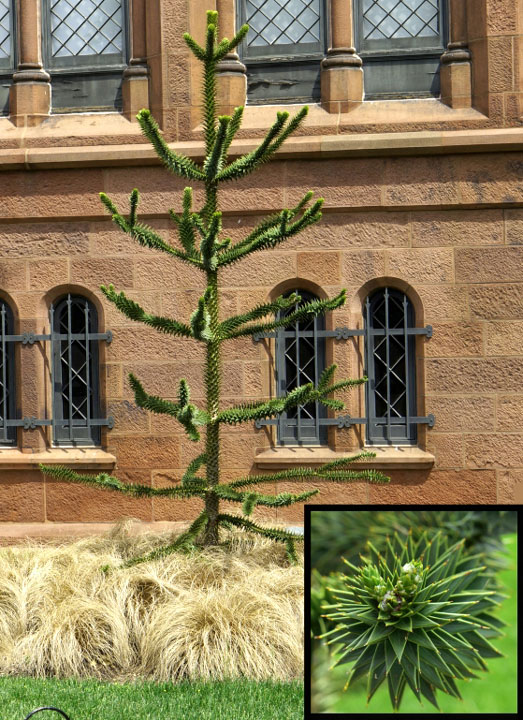|
The future is unwritten
Join Date: Oct 2002
Posts: 71,105
|
October 11th, 2015: Monkey Puzzle Tree
This is a picture Walking Man could have taken, as this tree is growing next to the Smithsonian castle. But did he? Noooooooooooooooo.  -------------------------
------------------------- 
Quote:
This monkey puzzle tree (Araucaria araucaria) is one of the stranger trees growing in the Smithsonian’s Enid A. Haupt Garden in Washington, D.C. Its triangular leaves, which cover the entire tree, both branches and trunk, are thick, tough, and scale-like, with sharp edges and tips. Each leaf can last 10 to 15 years.
The tree’s common name reportedly stems from a comment made by an Englishman in the mid-1800s. He noted that it would be a puzzle for a monkey attempting to climb such a well-armed tree. Even though there are no monkeys in the tree’s native habitat on the lower Andean slopes of Chile and Argentina, the remark caught the public’s attention and evolved into the tree’s name.
|
link
Leaves that live longer than many pets?  I wonder how long the tree will live?
Oh, Wiki says...
Quote:
Araucaria araucana (commonly called the monkey puzzle tree, monkey tail tree, Chilean pine, or pehuén) is an evergreen tree growing to 40 m (130 ft) tall with a 2-m (7-ft) trunk diameter. The tree is native to central and southern Chile and western Argentina. Araucaria araucana is the hardiest species in the conifer genus Araucaria. Because of the great age of this species, it is sometimes described as a living fossil. Its conservation status was changed to Endangered by the IUCN in 2013 due to its declining abundance.
~~~~~~~~~~~~
Its piñones, or seeds, are edible, similar to large pine nuts, and are extensively harvested in Chile. The tree has some potential to be a food crop in other areas in the future, thriving in climates with cool oceanic summers, e.g., western Scotland, where other nut crops do not grow well. A group of six female trees with one male for pollination could yield several thousand seeds per year. Since the cones drop, harvesting is easy. The tree, however, does not yield seeds until it is around 30 to 40 years old, which discourages investment in planting orchards (although yields at maturity can be immense); once established, it can live possibly as long as 1,000 years.
|
I wonder if Euell Gibbons knew about this? Whoa, 1000 years, they live a lot longer than pets, or us.
__________________
The descent of man ~ Nixon, Friedman, Reagan, Trump.
|




 I wonder how long the tree will live?
I wonder how long the tree will live?